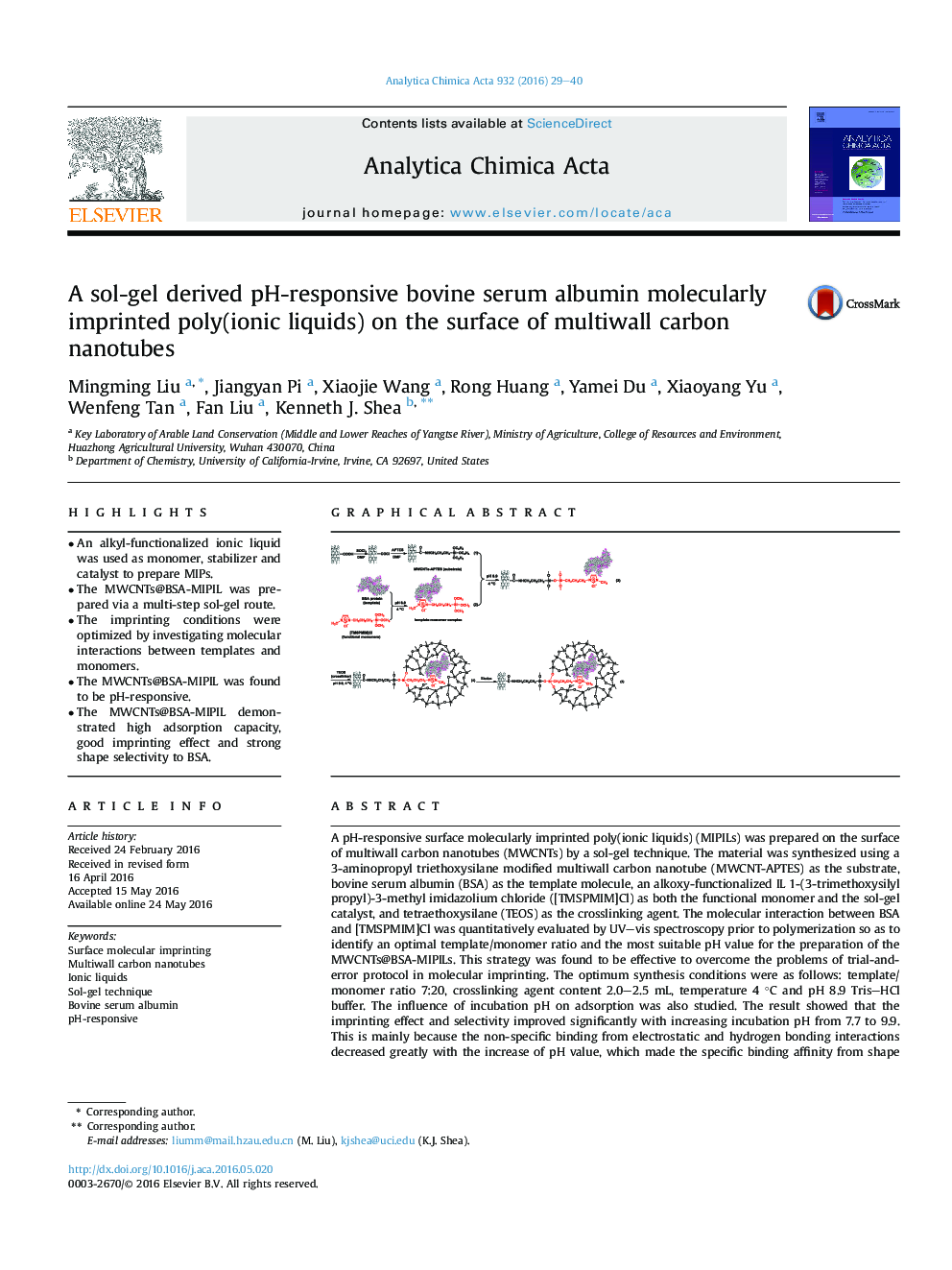| کد مقاله | کد نشریه | سال انتشار | مقاله انگلیسی | نسخه تمام متن |
|---|---|---|---|---|
| 1162779 | 1490900 | 2016 | 12 صفحه PDF | دانلود رایگان |

• An alkyl-functionalized ionic liquid was used as monomer, stabilizer and catalyst to prepare MIPs.
• The MWCNTs@BSA-MIPIL was prepared via a multi-step sol-gel route.
• The imprinting conditions were optimized by investigating molecular interactions between templates and monomers.
• The MWCNTs@BSA-MIPIL was found to be pH-responsive.
• The MWCNTs@BSA-MIPIL demonstrated high adsorption capacity, good imprinting effect and strong shape selectivity to BSA.
A pH-responsive surface molecularly imprinted poly(ionic liquids) (MIPILs) was prepared on the surface of multiwall carbon nanotubes (MWCNTs) by a sol-gel technique. The material was synthesized using a 3-aminopropyl triethoxysilane modified multiwall carbon nanotube (MWCNT-APTES) as the substrate, bovine serum albumin (BSA) as the template molecule, an alkoxy-functionalized IL 1-(3-trimethoxysilyl propyl)-3-methyl imidazolium chloride ([TMSPMIM]Cl) as both the functional monomer and the sol-gel catalyst, and tetraethoxysilane (TEOS) as the crosslinking agent. The molecular interaction between BSA and [TMSPMIM]Cl was quantitatively evaluated by UV–vis spectroscopy prior to polymerization so as to identify an optimal template/monomer ratio and the most suitable pH value for the preparation of the MWCNTs@BSA-MIPILs. This strategy was found to be effective to overcome the problems of trial-and-error protocol in molecular imprinting. The optimum synthesis conditions were as follows: template/monomer ratio 7:20, crosslinking agent content 2.0–2.5 mL, temperature 4 °C and pH 8.9 Tris–HCl buffer. The influence of incubation pH on adsorption was also studied. The result showed that the imprinting effect and selectivity improved significantly with increasing incubation pH from 7.7 to 9.9. This is mainly because the non-specific binding from electrostatic and hydrogen bonding interactions decreased greatly with the increase of pH value, which made the specific binding affinity from shape selectivity strengthened instead. The polymers synthesized under the optimal conditions were then characterized by BET surface area measurement, FTIR, thermogravimetric analysis (TGA) and scanning electron microscopy (SEM). The adsorption capacity, imprinting effect, selective recognition and reusability were also evaluated. The as-prepared MWCNTs@BSA-MIPILs were also found to have a number of advantages including high surface area (134.2 m2 g−1), high adsorption capacity (55.52 mg g−1), excellent imprinting effect (imprinting factor of up to 5.84), strong selectivity (selectivity factor of 2.61 and 5.63 for human serum albumin and bovine hemoglobin, respectively), and good reusability.
A pH-responsive bovine serum albumin molecularly imprinted poly(ionic liquids) was prepared on the surface of multiwall carbon nanotubes via a sol-gel route. The specific binding from shape selectivity was significantly strengthened by controlling the non-specific binding by adjusting the incubation pH value to 9.9. The use of ionic liquids as stabilizers, functional monomers and sol-gel catalysts was found to be a promising strategy for the preparation of water compatible molecularly imprinted polymers for protein molecules.Figure optionsDownload as PowerPoint slide
Journal: Analytica Chimica Acta - Volume 932, 17 August 2016, Pages 29–40